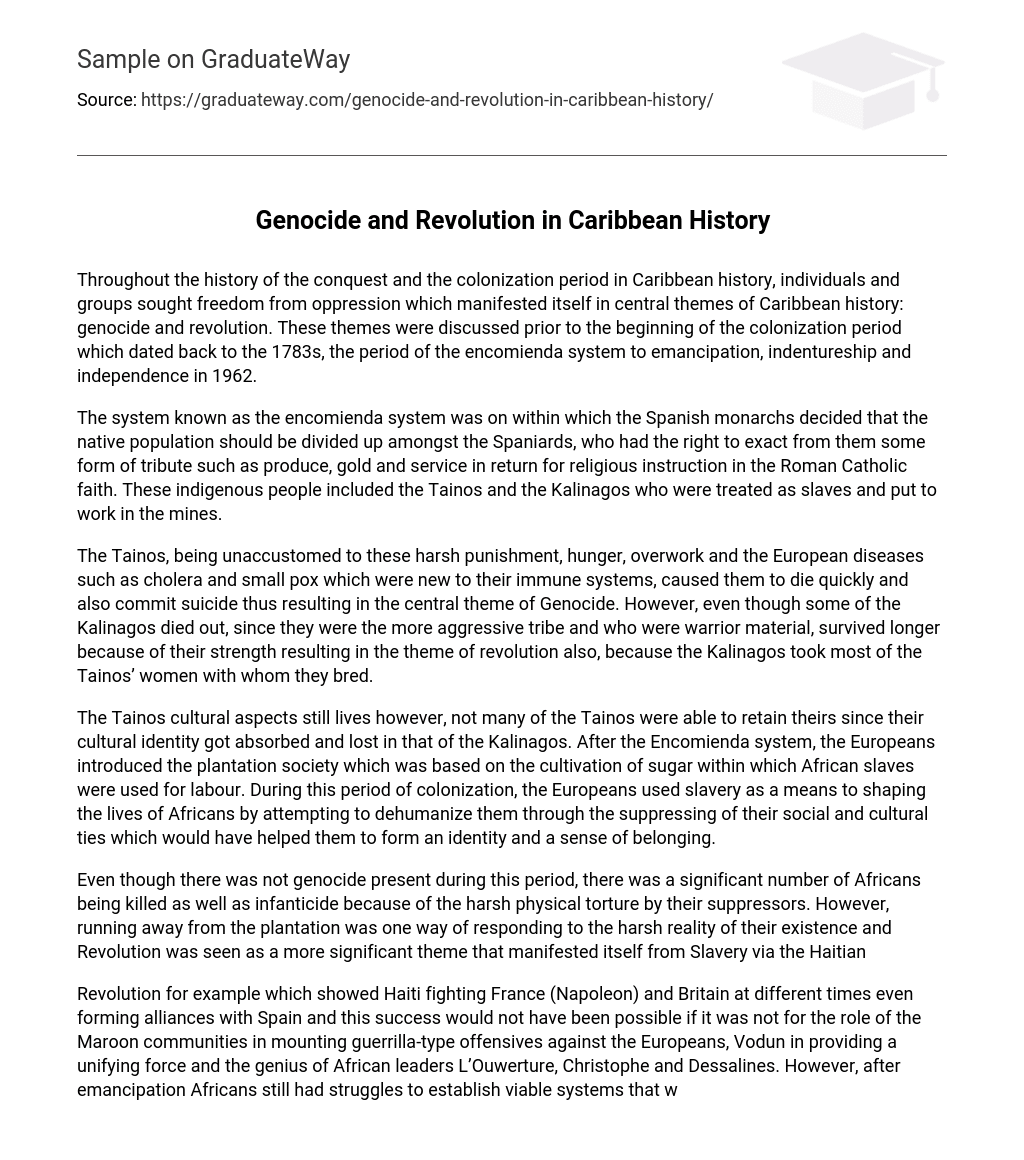Throughout the history of the conquest and the colonization period in Caribbean history, individuals and groups sought freedom from oppression which manifested itself in central themes of Caribbean history: genocide and revolution. These themes were discussed prior to the beginning of the colonization period which dated back to the 1783s, the period of the encomienda system to emancipation, indentureship and independence in 1962.
The system known as the encomienda system was on within which the Spanish monarchs decided that the native population should be divided up amongst the Spaniards, who had the right to exact from them some form of tribute such as produce, gold and service in return for religious instruction in the Roman Catholic faith. These indigenous people included the Tainos and the Kalinagos who were treated as slaves and put to work in the mines.
The Tainos, being unaccustomed to these harsh punishment, hunger, overwork and the European diseases such as cholera and small pox which were new to their immune systems, caused them to die quickly and also commit suicide thus resulting in the central theme of Genocide. However, even though some of the Kalinagos died out, since they were the more aggressive tribe and who were warrior material, survived longer because of their strength resulting in the theme of revolution also, because the Kalinagos took most of the Tainos’ women with whom they bred.
The Tainos cultural aspects still lives however, not many of the Tainos were able to retain theirs since their cultural identity got absorbed and lost in that of the Kalinagos. After the Encomienda system, the Europeans introduced the plantation society which was based on the cultivation of sugar within which African slaves were used for labour. During this period of colonization, the Europeans used slavery as a means to shaping the lives of Africans by attempting to dehumanize them through the suppressing of their social and cultural ties which would have helped them to form an identity and a sense of belonging.
Even though there was not genocide present during this period, there was a significant number of Africans being killed as well as infanticide because of the harsh physical torture by their suppressors. However, running away from the plantation was one way of responding to the harsh reality of their existence and Revolution was seen as a more significant theme that manifested itself from Slavery via the Haitian
Revolution for example which showed Haiti fighting France (Napoleon) and Britain at different times even forming alliances with Spain and this success would not have been possible if it was not for the role of the Maroon communities in mounting guerrilla-type offensives against the Europeans, Vodun in providing a unifying force and the genius of African leaders L’Ouwerture, Christophe and Dessalines. However, after emancipation Africans still had struggles to establish viable systems that would make freedom into more than just a hand-to-mouth existence.
After the period of Emancipation, the European needed new labour which was then sourced from India. This period was called indentureship within which the indentured labourers were contract labour who were free to return home at the end of the period of indentureship or remain in the Caribbean given a piece of land. Indentureship can be described as another form of slavery except that the labourers were not property and were allowed to practice their culture, religion and language.
However, even though during this period the theme of genocide was not significant, many indentured labourers died from poor nutrition and they suffered from malaria, yaws, typhoid and dysentery and the rate of suicide was high. This resulted in the resistance of labourers which was a Quiet Revolution in which there were protests and widespread unrest in Guyana and Trinidad and culminated a serious outbreak on Leonora Estate in Guyana in 1869.
However, most of them were able to establish some small business which represented their resilience amidst every kind of hardship and were a very productive form of resistance resulting in the theme of revolution since these labourers quickly became independent of the plantation and if they chose to work there after the period of indentureship they usually had other economic interest. This meant that the indentured labourers were now land owners as well and therefore had some power and wealth as compared to the African enslaves.
From emancipation until the end of the nineteenth century, Caribbean people were now beginning to understand what freedom meant and were recovering from the trauma associated with enslaved and bonded labour during the oppressive periods as it been in the era that had gone before. The period of independence resulted in the theme of revolution as well as political themes which moved most of the Caribbean countries from being colonized by the Europeans to one which it governed its own affairs.
This also resulted in access to education, and economic as well as political enfranchisement to name a few. In conclusion, it is evident that genocide was a central theme in Caribbean history but mainly during the encomienda system however, revolution as another central theme of Caribbean history was proven to have existed in the Caribbean during the encomienda system until independence of most Caribbean countries after the periods of emancipation and indentureship which made Caribbean people realise how much freedom meant to them.





